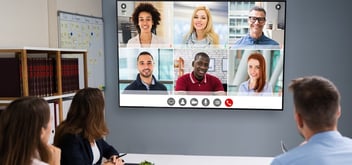Technology is changing the way we work. The current workplace is no longer a single place people go to do their jobs. With advances in mobile devices, networks and cloud computing, employees can now work anywhere, anytime with just a laptop and an internet connection.
This enables enhanced staff flexibility, collaboration and productivity never before seen in the workplace. However, to achieve the best results, companies not only need to provide the right workplace technology and tools for people to do their work but also create a working environment that caters to individual needs and preferences.
In this post, we focus on some valuable insights to help you create a workplace culture that adapts to advances in technology, and more importantly, delivers greater efficiency, productivity, flexibility and employee job satisfaction.
As a small to medium business, what are the things you can do to future-proof your workplace?
For a growing business, it’s important to make sure that the decisions you make today are still going to be relevant in the future, as change can happen so quickly. Here are some key actions to future-proof your workplace:
- Review the current environment: The first step is to get a full view of the current work environment. You need to know what is and isn’t working. Try to include your staff and the key stakeholders in the business and understand their current needs. Also, do a review of the workplace technologies currently in place – and how people are engaging with those technologies.
- Make sure people are communicating effectively: One of the biggest hurdles in growing your business is making sure people are communicating effectively. Communication is fundamentally critical to anyone’s business. So, what technologies do your staff use to communicate? How effective are they to date? How can you overcome the challenges they’re experiencing? Then make sure the tools and technologies you invest in are simple and easy to use.
- Engage a trusted partner: Yes, tools are becoming easier to use, but most people still feel overwhelmed with new technology. Therefore, it’s important at an early stage to engage with a trusted partner to help with the discovery piece and plan the move forward. This partner can also run workshops with stakeholders in different departments and groups to understand technology needs across the organisation.
- Look to the future: Think Nokia or Kodak. They were market leaders at some point but failed to adjust to future market needs. So often we make decisions today based on historical facts that are now obsolete. It’s not so much about what you want to do today, but more about how you want to position your company in the future. Think about where you want to go and how you can add value to your customers in the years to come.
What role does workplace technology play in helping your employees become more innovative and creative?
We all know that the greatest resource for any business is its people. There are two ways technology can add value to your employees and help them become more innovative and creative:
1. Customising the experience
It’s important to realise that most of your staff just go to the office to do the work they need to do and collect a pay cheque. That’s the reality. So, how can you help them to be more innovative and creative in their work? It is essential that you treat your employees with respect and understand that every employee is an individual, with their own needs and preferences.
You need to customise the experience for them. And technology plays a big role in doing just that. Tools and applications can be customised to suit employees’ life and work styles. Mobile and digital technologies can also make life easier for your staff – providing greater flexibility, efficiency and productivity. In essence, technology can give people more time to think creatively and focus on the more important things at work and in their personal lives.
2. Enhancing workplace culture
When people come together and collaborate at work, technology often works in the background and is not given much thought as it works on demand. However, technology plays an important role in enhancing the workplace culture. For instance, digital signage in the office can actually help inspire people at work. You can tell stories about the business, where it’s going and the success it’s currently having.
If you’re working with teams interstate or all over the world, how can you ensure people get the best experience with video conferencing?
We’ve all experienced some sort of frustration when connecting with people via video conferencing. We hear comments like ‘I can’t hear you’ or ‘your video froze’ or even ‘connection just dropped’. So, how can you ensure the best experience?
It’s important to start with understanding your company’s communication needs. What would make it easier for them to communicate with each other? How will employees use video conferencing? Is video conferencing the best solution? Of course, you first need to make sure that the technology would be widely adopted by the different teams before you invest in improving the experience.
With the internet and Wifi connectivity becoming stronger, more stable and a lot quicker, people expect video conferencing to just work. If it doesn’t, they will find another way to communicate. We always try to find the easiest way to get things done. While video conferencing is important, it is not the only way to communicate. Businesses need to be able to offer employees a lot of choices when it comes to communication – audio, video, email and text.
How can IT departments manage the security of sharing and storing information, especially across cloud platforms?
Security needs to be at the core of your technological and digital initiatives. You need to understand the flow of information across your organisation. Business data could be emailed, shared on social channels or stored on the cloud in applications like, OneDrive, Dropbox or Google Drive.
But how secure is the cloud? Cloud applications are getting more and more secure plus companies are now better at implementing security protocols and measures to protect business data.
The bigger threat isn’t the cloud – it’s the internet of things (IoT). IT departments need to be more concerned about the devices, machines and apps connecting to the network. These ‘things’ connect to anything and have the ability to transfer data over a network without requiring human interaction.
Also, stay tuned for Part 2 of this blog, as we go deeper into the experts’ discussion on how technology drives workplace transformation! Subscribe to our blog to make sure you don’t miss out and also read our Guide to the Future of Work.
Want to learn more about technology in the workplace? A design partner can help future-proof your business by implementing the right technologies to achieve your long-term objectives.
Check out our free ebook 'Digital Transformation: The Role of Workplace Strategy'







